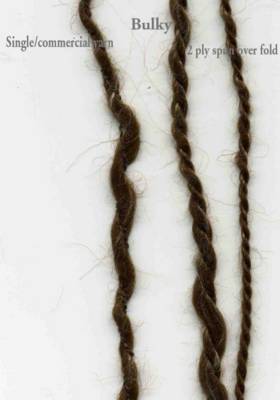Usually when spinning roving, I can just spin straight off the end of the roving. The fibers are aligned and I have no problem spinning a nice smooth yarn. Once in awhile, just like this roving I find that spinning straight off the end, I run into several problems. One the fiber seems compacted in some areas and not in others, and even drafting doesn't keep clumps from jumping into the twist while I spin. Another problem, probably related is I run into areas where the fiber just runs out, like all of the fibers ended right in the same spot.
At first I thought I would solve this problem roving by just drafting as evenly as I could, and spinning with a very light twist, very slowly, and making a bulky yarn. I still had lots of thick and thin areas doing this though, and was not happy with the resulting yarn. In a moment of playfulness, I tried taking the thick single and plying it with a commercial yarn from a cone of machine knitting yarn. The thought behind trying this was, if the thick single was already thick and thin, wrapping a commercial yarn around it tightly would create even more of that effect. It seems like it would work. What I found though was even spinning with high twist, the alpaca refused to be wrapped with the commercial yarn, and the resulting yarn looked like roving just barely spun. It was highlighted the two things I didn't like about the alpaca, that it wouldn't take a good twist and hold it, and that the slippery fibers refused to be wrapped. I think it might look good once knitted, but in the long run it was not a yarn I really wanted to make.
This morning, I finally remembered my solution to a previous roving like this, a technique called spinning from the fold. I got out my wheel, took a hunk of roving and folded it over my index finger and fed the fiber into the drafting triangle from that fold. It worked wonderfully, and I was able to create a yarn that will be of the same WPI as other alpaca yarns I have spun. This was necessary if I really wanted to make something from this yarn, since I only have about 6 oz of this roving.
In the picture below, the first yarn is the single plied with the commercial yarn, the middle yarn is the bulky 2 ply and the final yarn is the 2 ply spun from the fold. The commercial yarn is very thin, and is not visable in the picture, and there is so little silk in the mixture that very little shows in any of the samples. That just hint of off white is the silk.

Three samples from an alpaca/silk roving.
I am glad I found a way to spin this roving because the color is a deep brown that I love. I am sure I bought the roving for the color with no idea I would have trouble spinning it. Now I can pair the yarn from this roving, with another alpaca color in a shawl.
CW
1 comment:
I like the fold-spun yarn! Very nice, and I can imagine how soft it is.
Also really like your comparison picture. One thought for the future (I know that documenting and keeping track of things is important to you)--you might want to think about including a ruler or a penny or something to give you a better visual record of scale--that way, if (god forbid) anything should happen to your physical records, your virtual records would be more useful.
Post a Comment